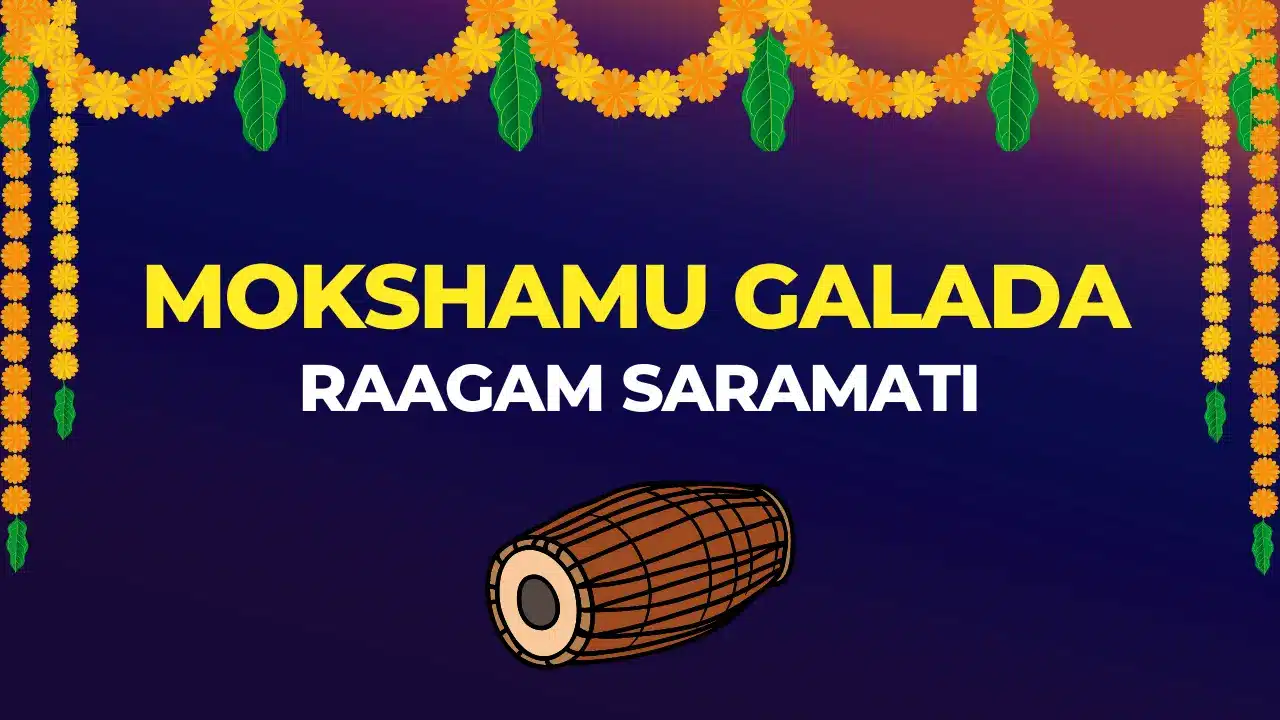Introduction
The kriti Mokshamu galada is set in the Raagam Saramati and it is composed by St.Tyagaraja, of the Carnatic Trinities’ fame. Raagam Saramati belongs to the list of Janya Raagam, derived from the 20th Melakartha Scale Natabhairavi. The descending order of Swaras doesn’t have all the seven swaras and that is the reason for it to be identified as a Janya Raagam.

Classical Carnatic music is but the continuance of ancient Indian music as it was prior to the advent of Persian influence and the attendant evolution of the Hindustani style.
Mokshamu Galada goes into the deep pondering about attaining Salvation, which is called Moksha in a few Indian languages. The song, set in this meditative Raagam, invokes Bhakthi rasa, which is devotion, and Karuna rasa, which is compassion.
Saramati
A raagam that can melt the audience collectively – this phrase aptly suits the Raagam Saramati. The unique swara combinations are Sa Ri Ga Sa / Da Ni Sa and Pa Da Ma Ga Sa. These two phrases can convey the mood of the Raagam aptly and does their duty to captivate and move the audience. The avarohanam of the Raagam does not contain Panchamam and Rishabam.
The Sampurna raagam scale of Natabhairavi and the pentatonic scale of Hindolam comes together birthing Saramati. The combination of both the raagams gives rise to a Sampurna-Audava Raagam.
Saint Tyagaraja
Kakarla Tyagabrahmam, (aka) Tyagayya, is regarded as one of the Trinity of Carnatic music, along with Shyama Shastri and Muthuswamy Dikshitar. Predominantly a Telugu composer, he has over thousands of compositions under his Turban. Many of the famous compositions that is sung over and over again even now, have a high probability of it being Tyagaraja’s composition.
The famous collections of Kritis called “Pancharatna Kritis” were composed by Tyagaraja. These are sung in many music festivals in the honour of the composer. The signature he leaves back in all his kritis is the usage of the word “Tyagaraja”.
Mokshamu Galada – Meaning
While living, what one lacks the most is self-realisation. Tyagaraja. In the pallavi of Mokshamu Galada, questions if Salvation is possible without self-realisation. There is an inner voice for everyone. In the Anupallavi, Tyagaraja quotes that devotion and intelligence about the actual spirituality in the heart is necessary for Salvation.
He states that the inner primordial sound in everyone is Om. The Charanam states that the seven notes is born out of that one word “Om”. Lord Shiva is known to experience the purity from the music of Veena. Without one realising Shiva’s true form, Tyagaraja states that, it is not possible to attain Salvation.
Song: Mokshamu gala
Raga: Saramathi
Tala: Adi
Composer: Thyagarajar
Aro: S R2 G2 M1 P D1 N2 Ṡ
Ava: Ṡ N2 D1 M G2 S
Lyrics
Pallavi
Mokshamu galadha puvilo
Jeevanmukthulu gaani vaaralaku
Anupallavi
Saakshaathkaara ni Sathbhakthi
Sangitha gnyaana Vihinulaku
(Mokshamu)

Did You Know?
Carnatic music, known as Karnataka sangita or Karnataka sangitam in the South Indian languages, is a system of music commonly associated with South India, including the modern Indian states of Andhra Pradesh, Karnataka, Kerala, Tamil Nadu and Telangana.
Charanam
Praananaala Samyogamu Valla
Pranava Naadhamu Saptha Swaramulai Paraka
Veenaa Vaadhana Loludow Siva mano
Vithameru garu Thyaagaaraaja Vinutha
(Mokshamu)
Notations
Pallavi
| ; , R ; G S , G , G , M G M , | | | ; P D P D N , | | | N D D M M G G M | || |
| Moksha mu ga la dha . . | | | pu vi lo . . | | | Jee . . . va n. . . | || |
| GS, R ; G S , G , G , M, R;G | | | M,P D D;N Ṡ | | | Ṡ N N D D M G M | || |
| Moksha mu ga la dha . . | | | pu vi lo . . | | | Jee . . . va n. . . | || |
| GS, R ; G S , G , G , M, R;G | | | M,PDPDDNṠRGS, | | | Ṡ N N D D M G M | || |
| Moksha mu ga la dha . . | | | pu vi lo . . | | | Jee . . . va n. . . | || |
| GS, SR, G S , R,G M , D,N Ṡ , | | | ;Ṡ;ṘṠ ṠN N;ṠN | | | ND DMMGGM | || |
| Mukthulu gaa ni. . . . | | | vaa . . . .ra. | | | . . la . . ku . . | || |
| GS, SR, GS , R,G M ;PD NṠ ṘĠ | | | Ṡ,ṠṘṠ ṠN N,ṠN | | | ND DM GMDM GMGG | || | S,- |
| Muk thulu gaa . ni . .. . . . . | . Vaa . . ra | . . la ku . . . . . . . | . . |
Anupallavi
Sangathi-1
| ;N Ṡ Ṙ ; Ġ , Ṙ , ṠṘĠṘ Ṙ , | | | ; Ṙ Ġ Ṡ , ; | | | ;Ṡ N N D P D | || | |
| Saakshaath kaa ra ni . .. . . . . | Sath . . . | Bhak . . thi . | || |
| ;NṠ, ṘĠṘĠ ṠṘ; Ġ, Ṙ, NṠṘĠ Ṙ, | | | ;ṀĠĠṠ; | | | ;Ṡ N N D DM | || | |
| – Saakshaath kaa ra ni . .. . . . . | Sath . . . | Bhak . . thi . | || |
| M; MP, D ; D, ; D , N Ṡ | | | ;Ṡ,ṘṠ ṠN N,ṠN | | | ND DMMG GM | || | GS,- |
| San gi tha gnyaa na | | | vi . . . hi | | | nu la ku | || | . . . |
Charanam
Sangathi-1
| ; , P , P , P , P , P ; D N | | | ; ND DN DM | | | MGG M GSRG | || | |
| praa na naa la Sam . . | | | Yo . . ga mu | | | Val . . la . . | || |
| MP-P , P , ; P , P , PDNṠ ṘĠṠ, | | | ; Ṡ N N D D M | | | DMGMGS RG | || | |
| Pra na naa la sam . . . . | | | Yo . . ga mu | | | Val . . . . la . . | || |
| MP MND, DM M , M , GMGS | | | ; S R, G S , | | | ; R, G, M, | || | GM,- |
| -pra nava Naa dha mu sap tha | | | Swa ra mu lai | | | Pa ra ka. | || | . . . |
Like Anupallavi
Veena Vaadhana Loludow Siva mano||
Vithameru garu | Thygaaraaja Vinutha||
(Mokshamu)
Viriboni is a composition that any novice learner has to master before moving on to the expert level
FAQs
What does the phrase Mokshamu Galada mean?
The phrase Mokshamu Galada means, is salvation possible.
Who composed Mokshamu Galada?
Mokshamu Galada was composed by Saint Tyagaraja.
Explain raagam Saramati?
Raagam Saramati is derived from the 20th Melakarta Raagam Natabhairavi. It is a Sampoorna Audava raagam. It means, the Ascending order, aarohanam has all the 7 swaras and the descending order, the avarohana has only 5 swaras. Panchamam and Rishabam, the two swaras are missing from the Avarohanam and this classifies this Janya raagam as the one in Pentatonic scale.
What kind of Raagam is Saramati?
The Raagam Saramati is a melting, mellifluous Raagam, which can move the Audience to tears if sung perfectly.
Where do we find the notes and notations of the Kriti Mokshamu Galada?
The notes and the notations of the Kriti Mokshamu Galada can be found above in the blog. This blog also contains information about the Raagam in which it was composed it and also about the composer who composed the Kriti.
What are the Aarohanam and Avarohanam of the Raagam Saramati?
The Aarohanam and the avarohanam of the Raagam Saramati is given in the blog above.
Related Blog: Evvari Bodhana – Abhogi Ragam































